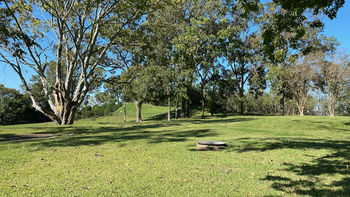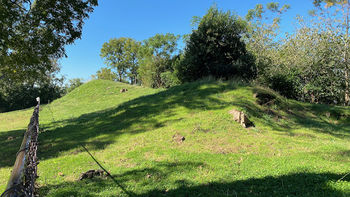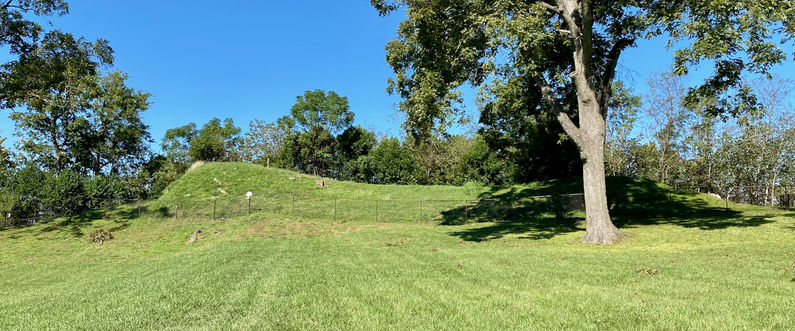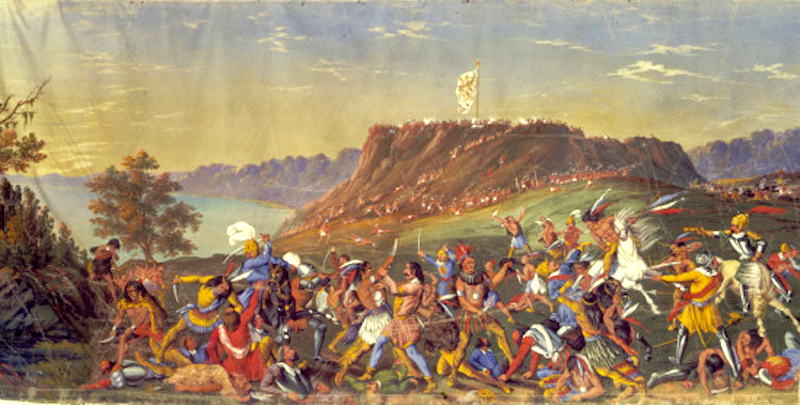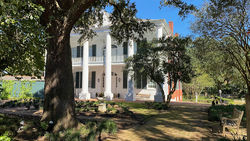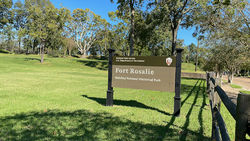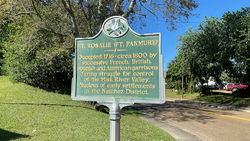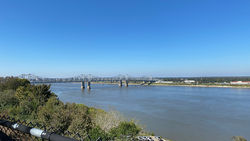Fort Rosalie
|
Fort Rosalie (1716-1799) - A French post established in 1716 by the governor of Louisiana, Jean-Baptiste Le Moyne de Bienville, in present-day Natchez, Adams County, Mississippi. Named for the duchess of Pontchartrain who was the wife of the French minister of marine. Burned by Indians in 1729. Taken over and rebuilt by the British after the French & Indian War and renamed Fort Panmure. The post was occupied by American forces during the Revolutionary War but retaken by the British in 1782 and then surrendered to the Spanish on 22 Sep 1783, and occupied by them until 1798. Occupied by Americans in 1798 but abandoned when Fort Adams (3) was completed in 1799. Also known as Fort les Natchez, Post at Natchez, Natchez Post, Fort Sargent and Fort Panmure. HistoryThe French established Fort Rosalie in 1716 after peace had been reached with the Natchez Indians. The then governor of Louisiana, Jean-Baptiste Le Moyne de Bienville, required the Natchez to provide both the materials and labor to build the fort on a high bluff overlooking the Mississippi River. The fort became the seat of local government, settlements and plantations grew up around the fort. There were scattered conflicts throughout the 1720s but Bienville managed to keep the peace. In 1724 governor Bienville was recalled to France and was replaced by Étienne de Perier who soon departed from Bienville's policies toward indigenous peoples. To oversee Fort Rosalie and the Natchez settlement, Perier appointed Sieur de Chépart. Chépart was described as "greedy, haughty, and tyrannical," and he abused soldiers, settlers, and the Natchez alike. Chépart and governor Perier conspired to establish a large plantation by appropriating lands that included the Natchez village of White Apple. The Natchez asked Chépart to delay the takeover until after the fall harvest and Chépart agreed. The Natchez used this time to plan a sophisticated attack on the settlers and the fort. Fort Rosalie MassacreThe Natchez executed their plan on 28 Nov 1729 when 30 Natchez warriors led by their chief, the Great Sun, entered Fort Rosalie explaining that they were on a hunting trip and would return with deer meat for the garrison. On a signal, the warriors shot or clubbed the soldiers, killing them all and then scalped and then beheaded them. The gunfire signaled other warriors who had infiltrated the settlements below and they too killed every Frenchman they could find. Accounts vary but Father Philibert related the French dead at 138 men, 35 women and, 56 children. A visitor to the site after the massacre reported that the Natchez had lined up the severed heads in two rows. The Natchez, expecting French retaliation for the massacre, built two palisaded forts next to their Grand Village and mounted the cannon from Fort Rosalie as a defense. French RetaliationWord of the Massacre had reached New Orleans quickly and a retaliatory expedition was formed. On 8 Feb 1730, the French arrived in front of the new Natchez Indian Forts and joined up with their Choctaws allies to prepare for a siege. On 22 Feb 1730, the Natchez attacked the French positions and almost routed the French. On 27 Feb 1730, the Choctaws attacked the Natchez and killed 100 of them, and captured 5 to 20. Among the dead was the White Apple Chief. By this time both the French and the Natchez Indians had established artillery positions and were firing at each other but they soon agreed to stop the shelling. On the night of 25-26 Feb 1730, the Natchez left both their forts, and most fled into present-day Louisiana. There was a common perception that the French had let the Natchez escape during the rainy night under the condition that they leave their hostages behind. The Natchez continued to wage a guerrilla war against the french until a large French expedition laid siege to the Natchez Fort at Sicily Island in present-day Louisiana. The fort was taken on 25 Jan 1731 and the occupants surrendered over the next days. Estimates say that almost 500 men women children surrendered and some 387 were transported to New Orleans, sold into slavery, and transported to Santa Domingo. Among those transported were were the young Great Sun, his mother, Tattooed Arm, and SaintCosme the last of the elite Sun lineage. Only 160 Natchez survived the voyage to Cape Francis. A new Fort RosalieThe French established a temporary fort to replace the burned-out original fort and set out to rebuild the original fort but with large earthworks built the shape of a pentagon surrounded by a dry moat. That fort remained in use by the French for some 30 years with a garrison of about 50 men. British Fort PanmureAt the end of the French & Indian War, the Treaty of Paris (1763) gave England both Spanish Florida and French Canada including Fort Rosalie. The British renamed Fort Rosalie, Fort Panmure after William Maule who was the Earl of Panmure. The British held the fort for 16 years until the Spanish Bernardo de Galvez conquered Baton Rouge (1779) and made the surrender of Fort Panmure a condition of the surrender of Baton Rouge. American ControlAt the end of the Revolutionary War in 1798, the United States took over the fort and created the Mississippi Territory with Natchez as its first territorial capital. The U.S. abandoned the fort in 1804 and moved the garrison to Fort Adams (3). Current StatusFort Rosalie is now a part of the Natchez National Historical Park. The site of the Fort is located just south of the Rosalie House in Natchez, Adams County, Mississippi. The site is located within a large grassy block along Canal Street that has a number of readerboards along the perimeter. The remains of the fort's main redoubt are located at a central high point at the crest of a tall bluff overlooking the Mississippi River. The site of a landside gun battery is located on an elevation below the main bastion. Neither of these defenses is well defined now and it takes a lot of imagination to know what they must have looked like. The remains of the redoubt are fenced off to limit public access. To get a full picture of the reason the fort existed one should visit the Grand Village of the Natchez Indians nearby and understand that there were also two Indian forts built between the Indian village and the French fort. A third fort was built in Louisiana by Indians fleeing the retaliating French forces.
See Also: Sources:
Links: Visited: 31 Oct 2020
| |||||||
